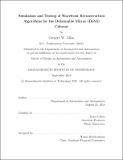| dc.contributor.advisor | Kerri Cahoy. | en_US |
| dc.contributor.author | Allan, Gregory W. (Gregory William) | en_US |
| dc.contributor.other | Massachusetts Institute of Technology. Department of Aeronautics and Astronautics. | en_US |
| dc.date.accessioned | 2019-02-14T15:22:55Z | |
| dc.date.available | 2019-02-14T15:22:55Z | |
| dc.date.copyright | 2018 | en_US |
| dc.date.issued | 2018 | en_US |
| dc.identifier.uri | http://hdl.handle.net/1721.1/120381 | |
| dc.description | Thesis: S.M., Massachusetts Institute of Technology, Department of Aeronautics and Astronautics, 2018. | en_US |
| dc.description | This electronic version was submitted by the student author. The certified thesis is available in the Institute Archives and Special Collections. | en_US |
| dc.description | Cataloged from student-submitted PDF version of thesis. | en_US |
| dc.description | Includes bibliographical references (pages 93-98). | en_US |
| dc.description.abstract | The search for exoplanets has discovered thousands of worlds orbiting stars other than our own. To learn more about these worlds, it is necessary to directly image them and study their atmospheric spectra. Especially of interest are Earth-like planets, but they are typically outshined by their host stars by a factor of 10₁₀, meaning high-contrast imaging is required to see them. Coronagraphs are typically used to block the starlight to achieve high contrast, but atmospheric, thermal, and mechanical aberrations can cause spurious speckles of starlight to contaminate the image. Use of space telescopes removes atmospheric aberrations, but other sources still remain. In order to achieve the optical performance necessary for high-contrast imaging, adaptive optics (AO) techniques in space are needed. High actuator count deformable mirrors (DMs) used in an AO system enable the required contrasts across sufficient fields of view, but typically have high size, weight, and power requirements, and can be complex to implement. New technologies such as Micro-electromechanical Systems (MEMS) DMs can potentially alleviate these problems. MEMS DMs also have applications in high-energy lasers, optical communications, and imaging systems. However, MEMS DMs have not been sufficiently tested in an orbital environment. While environmental tests can be performed on the ground, on-orbit operation in vacuum with exposure to radiation for extended periods cannot be sufficiently simulated. If MEMS DMs are to gain acceptance for use in future space missions, interactions with other system components must be studied, and support systems suitable for operating the DM in the space environment with constrained size, power, and computation resources must be developed. This thesis discusses the Deformable Mirror Demonstration Mission (DeMi), which aims to address these needs. Specifically, we develop and demonstrate wavefront sensing approaches suitable for demonstrating and characterizing a MEMS DM on a small satellite platform. | en_US |
| dc.description.statementofresponsibility | by Gregory W. Allan. | en_US |
| dc.format.extent | 98 pages | en_US |
| dc.language.iso | eng | en_US |
| dc.publisher | Massachusetts Institute of Technology | en_US |
| dc.rights | MIT theses are protected by copyright. They may be viewed, downloaded, or printed from this source but further reproduction or distribution in any format is prohibited without written permission. | en_US |
| dc.rights.uri | http://dspace.mit.edu/handle/1721.1/7582 | en_US |
| dc.subject | Aeronautics and Astronautics. | en_US |
| dc.title | Simulation and testing of wavefront reconstruction algorithms for the deformable mirror (DeMi) cubesat | en_US |
| dc.type | Thesis | en_US |
| dc.description.degree | S.M. | en_US |
| dc.contributor.department | Massachusetts Institute of Technology. Department of Aeronautics and Astronautics | |
| dc.identifier.oclc | 1084482108 | en_US |
